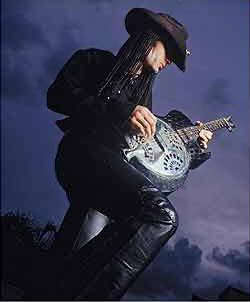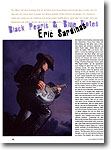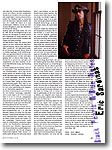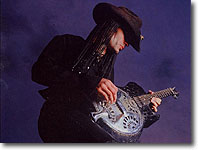|
press and media >> gitarre & basse (germany) >> eric sardinas: black pearls & blue notes date >> november 2003 author >> arnd müller photos >> favored nations translation & scans >> maike Eric Sardinas: Black Pearls & Blue Notes |
|
Sardinas is a very versatile musician, a virtuoso, who plays quite an extraordinary instrument as well -- a resonator guitar, equipped with pick-ups. These are features which one day drew Steve Vai's attention toward Sardinas. He signed him to his label Favored Nations, which was a stroke of luck for Eric: "I have great respect for Steve's music and he respects my music. My creativity is understood and appreciated. I couldn't imagine being surrounded by a more decent group of people when I'm working on a record. I would never compromise on what I'm doing, and it's good to know that they respect me for that." Eric, who was born in Fort Lauderdale, Florida, and is now living in Los Angeles, started to play guitar when he was six. "I had an acoustic guitar and I've always liked the feeling you have when you are playing on such an instrument. My parents wanted me to learn to play an instrument and they chose the guitar. I'm left-handed but I play like a right-hander." His early influences were Motown, R&B, Soul, Elvis Presley and Ray Charles. When he was about twelve, he discovered blues and rock and listened to Cream, Led Zeppelin, Rory Gallagher, Jimi Hendrix and The Allmann Brothers. "I wanted to advance these traditional sounds with the help of rock & roll and blues. One day I took a drill and installed pick-ups into my guitar. 15 years later it is both: my electric and my acoustic guitar." The specific feature about Eric's instrument: it's an acoustic resonator guitar. The model he brought for the interview is one of his main instruments, a Gibson. The installed pick-up is a Seymour-Duncan Humbucker, made to [Eric's] specification. Now, there's also a resonator signature model available, which is shortly named "ES" The guitar is available in two versions, one is an acoustic-resophonic [Washburn ES10] and one is equipped with a pick-up [Washburn ES20]. Sardinas plays very heavy strings, from .013 to .059. On his right hand he uses a thumbpick made of metal, and a single-steel-pick on his index finger, but he also strokes with the other three fingers. On his little finger he wears a messed-up looking slide made of metal. "That's my good-luck-slide," explains Eric. " I have used it for thousands of concerts. This thing landed in the audience, behind the stage and somehow I always got it back. I'm not superstitious, but I set my heart on this slide. Dunlop took it, weighed it and measured it out and then they put a new slide on the market which is called "Preaching Pipe." Sardinas has literally tried everything as a bottleneck, "from a chicken's bone to a screwdriver," he says. However, due to his aggressive stroke, only metal is a possibility for him, as a bottleneck of glass would break too easily. Apart from that he uses a capo: "I love a little bit more tension when I'm playing with an open tuning. My capo is made by Dunlop and is called "trigger." A couple of times I even used six capos on one guitar neck at the same time..." Sardinas prefers open D tuning (D-A-D-G-F#-D), but he also uses open G (D-G-D-G-B-D) and open C (C-G-C-G-C-E). Sometimes he also plays in regular tuning, but not on his new album. For one song on his new album "Black Pearls" he also used the open Ab tuning (Eb-Ab-Eb-Ab-C-Eb). In the studio they tried different combinations of amps, such as: old 60's Marshall cabinets with a Vox Top, or Sardinas' Custom-Rivera amp with a small 4x12-Matchless box, as well as a small Fender amp. For the final guitar sound they often recorded in parallel and mixed a microphoned acoustic signal and the tone of the electric guitar (received from the amp/boxes by a microphone). By the way, the producer was a living legend: Eddie Kramer. "Later he would turn the take with the sound of the amp softer, so the acoustic sound could be heard more clearly. That's one of his tricks. Do you know "I Don't Live Today" from Hendrix? Towards the end he starts to speak and the band gets softer. That's really original! Eddie Kramer does things I would never think of!" Sardinas seems to be very taken with the collaboration with Kramer, who has not only worked with Hendrix but also with Kiss and Led Zeppelin. "Eddie's way of working is much the same as my way of playing. He's got his own ideas. He experiments a lot on the amps to get all these crazy sounds, he plays around -- and that was really fun, since it was a very creative period and also very relaxed. I think that Eddie's energy was a great advantage, and it helped to turn the studio into a perfect place for making music." Indeed, "Black Pearls" sounds full, very much like classic rock albums, and rich in nuance. "I found out that I have become more open-minded concerning music, rhythm and especially lyrics. I took a step further than on the first two albums. The key to these songs was the fact that the live sound in the studio really had to be transferred to the record. When you are listening to albums Eddie has produced, no matter if they are from Hendrik or Led Zeppelin, you forget that you are only listening to a record. It feels as if you were in the studio. There's nothing between you and the music. I wanted the same energy on my album -- to show the music in its true light, so that it reflects on the one hand the warmth and the integrity of a studio album, and on the other hand the honesty of a live album." Basically the band, in addition to Eric there's bassist Paul Loranger and drummer Mike Dupke, recorded live. Each instrument was recorded in another room to avoid heterodyning. "For some songs I added a guitar as an overdub to give it more depth," Eric explains. "Of course, I can't do that on stage since I only have two hands. But when we record I hear different harmonies in my head, almost like an orchestra, and that's what I sometimes want to project on tape to heighten some parts." Remarkable for Sardinas was his collaboration with legendary blues musicians within the last couple of years, such as those with Howlin' Wolf's sideman Hubert Sumlin and blues rock guitarist Johnny Winter. One of his most significant meetings was, according to Eric, his recording with the delta blues icon Honeyboy Edwards. "He is one of the last remaining of the first generation of the traditional delta blues. He was with Robert Johnson on the night he was poisoned. He was there! Until then my style of blues had been very rock-oriented, and for me it was important to go all the way back to pay tribute to the blues. We recorded the song in a hotel room, with two microphones. He had written "Gambling Man Blues" in the 40's or 50's. I wanted to play one of his songs, just as I had done it with Hubert Sumlin and Johnny Winter before." In his own music Sardinas combines these archaic influences with rock, which is certainly a problem for dogmatic blues fans. "Probably", Eric replies, "but I'm not a person who claims to be a blues purist. I've been lucky enough to have played with almost every living blues musician. My respect for the blues is honest and deep. I think that blues is about being honest to yourself, and it's about knowing who you are. Playing something and trying to make it sound as if it was from 1936 -- that's not me. I feel something inside of me, and that's my love for the music. When you are listening to "Flames Of Love" from my new album you realize that it comes from there. No matter what blues is -- that's my blues." scans by maike |
|
This man with his cowboy hat is really one in a million, there aren't many musicians of that sort around who play the blues with so much energy. Slide guitarist and singer Eric Sardinas knows very well about the tradition of good old blues, but with his interpretation of blues rock he gives a fresh impetus to this genre. The music of Eric Sardinas is filled with the spirit of the classical power trios from the late sixties and early seventies. The more intimate moments on his new album "Black Pearls," which is the third album after "Treat Me Right" (1999) and "Devil's Train" (2001), form a contrast to that spirit and the traditionally-minded 32-year-old devotes himself to the blues, and sometimes even adds country elements. |





|
WALLPAPER |